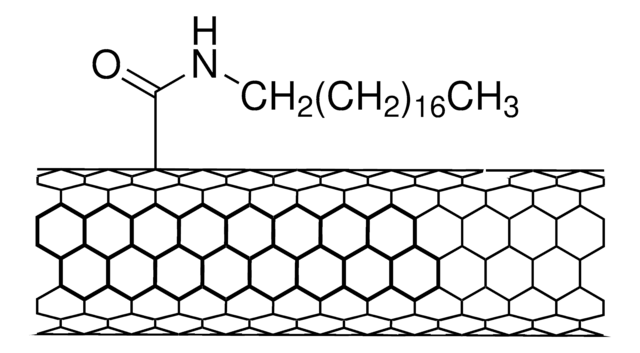698695
Carbon nanotube, single-walled
>70 wt. % carbon basis, D × L 2-10 nm × 1-5 μm , bundle dimensions, avg. no. of layers, 1
Synonym(s):
SWCNT, SWNT, Single wall carbon nanotube
About This Item
Recommended Products
Quality Level
Assay
>70% carbon basis (wt.)
feature
avg. no. of layers 1
composition
carbon, ≥70%
D × L
2-10 nm × 1-5 μm , bundle dimensions
size
1.3-1.5 nm , individual SWNT diameter
mp
3652-3697 °C (lit.)
density
1.7-1.9 g/cm3 at 25 °C (lit.)
SMILES string
[C]
Looking for similar products? Visit Product Comparison Guide
Application
Preparation Note
Analysis Note
Storage Class Code
11 - Combustible Solids
WGK
WGK 3
Flash Point(F)
Not applicable
Flash Point(C)
Not applicable
Personal Protective Equipment
Choose from one of the most recent versions:
Already Own This Product?
Find documentation for the products that you have recently purchased in the Document Library.
Customers Also Viewed
Polymeric Nanocomposites for Bone Tissue Engineering
carbon nanotube buckypaper-modified electrodes
Articles
Carbon nanotubes are materials that possess remarkable properties and offer extraordinary possibilities.
Carbon nanomaterials (CNMs), such as single-walled carbon nanotubes (SWCNTs), multi-walled carbon nanotubes (MWCNTs), and graphene (Figure 1), have diverse commercial applications including lighter and stronger composite materials, improved energy storage devices, more sensitive sensors, and smaller transistors.
Carbon nanotubes (CNTs) have received much attention since their discovery in 1991 by Sumio lijima1 due to their excellent mechanical, electrical, and optical properties.
A nanocomposite is typically defined as a mixture between a host material (e.g., polymer matrix) and nanofillers with at least one dimension of less than 100 nm.
Protocols
Single-Walled Carbon Nanotubes: Exfoliation and Debundling Procedure
Single-Walled Carbon Nanotubes synthesized by the Super-Growth Method & their properties & applications, including dispersing SGCNTs, SGCNT-polymer composites & SGCNT-metal composites are discussed.
Our team of scientists has experience in all areas of research including Life Science, Material Science, Chemical Synthesis, Chromatography, Analytical and many others.
Contact Technical Service




